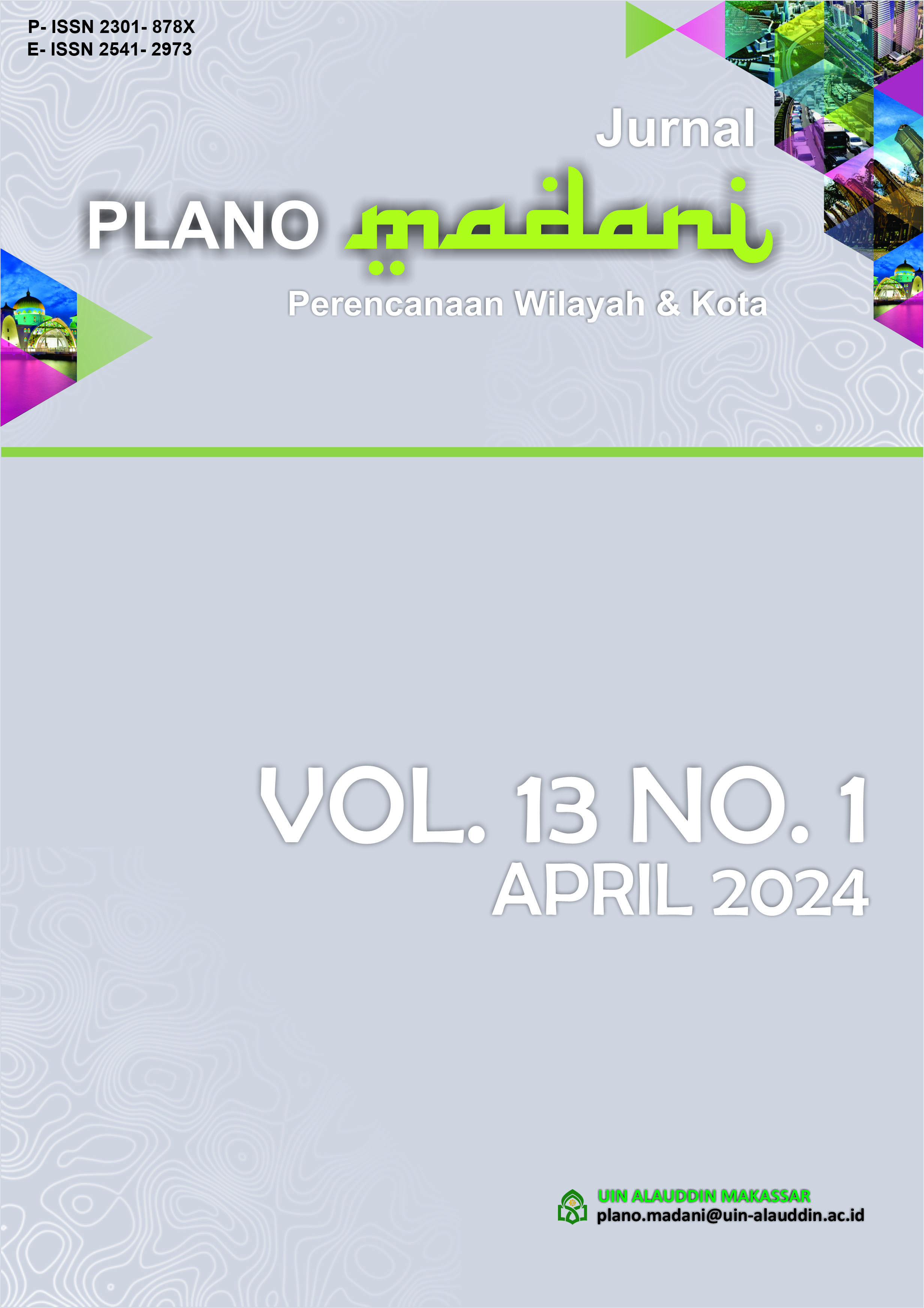THE INFLUENCE OF THE JAKARTA-BOGOR COMMUTER RAIL ROUTE ON AREA DEVELOPMENT AND ITS POTENTIAL IN SUPPORTING TRANSIT-ORIENTED DEVELOPMENT
Abstract
This study examines the impact of the Jakarta-Bogor commuter rail line on the intensity of residential area development around the stations and its potential in supporting transit-oriented development in the future. The research highlights the crucial role of the commuter train in integrating various regions, creating networks that influence regional development, particularly in areas around the stations. Qualitative methodology is employed, including field observations and semi-structured interviews with stakeholders such as real estate developers, property agents, and government institutions. The findings indicate that the commuter train significantly affects the development of low-density housing around the stations. This underscores the need for government oversight to manage the rapid urbanization in these areas by promoting the realization of high-density residential areas supported by various spatial functions, as prerequisites for Transit-Oriented Development (TOD) in the Jabodetabek region. The study recommends revising spatial planning around the stations to encourage a synergistic approach between public transportation and urban area development, as well as urban redevelopment or revitalization.
Downloads
References
ANTARA News. (2021). Over 166 thousand vehicles left Greater Jakarta on Dec 30. https://en.antaranews.com
Badan Pusat Statistik. (2021). Jumlah Penumpang Kereta Api di Jakarta, Bogor, Depok, Tangerang, dan Bekasi (Jabodetabek) pada Bulan April 2021. https://www.bps.go.id/indicator/16/174/1/jumlah-penumpang-kereta-api-di-jakarta-bogor-depok-tangerang-dan-bekasi-jabodetabek.html
Behr , C., & Yonkin, P. (2014). Understanding Development around Rail Transit Stations. https://www.masstransitmag.com/rail/article/11461267/understanding-development-around-rail-transit-stations
Carlton, I. (2019). Transit planners’ transit-oriented development-related practices and theories. Journal of Planning Education and Research, 39(4), 508-519.
Colliers International Indonesia. (2023). Jakarta CBD Office Market Overview - H1 2022. https://www.colliers.com
Danisworo, M. (1988). Konseptualisasi Gagasan dan Upaya Penanganan Proyek Peremajaan Kota. https://www.nawasis.org/portal/galeri/read/pendekatan-peremajaan-kota/52136
Giuliano, G., & Hanson, S. (2017). The geography of urban transportation. Guilford Publications.
Harvard Graduate School of Design. (2020). Analytic Methods of Urban Planning: Qualitative. https://www.gsd.harvard.edu/course/analytic-methods-of-urban-planning-qualitative-fall-2020/
Irsal, R. M., Hasibuan, H. S., & Azwar, S. A. (2022). Spatial Modeling for Residential Optimization in Dukuh Atas Transit-Oriented Development (TOD) Area, Jakarta, Indonesia. Sustainability, 15(1), 530.
Jakarta Propertindo. (2024). Mengenal Kawasan Berorientasi Transit di Jakarta. https://jpi.or.id
Jakarta Smart City. (2024). Mengenal Transit Oriented Development di Jakarta. https://smartcity.jakarta.go.id
Knight Frank. (2022). Jakarta’s office market to see new opportunities in 2022. https://www.knightfrank.com
Mahardhika, L. A. (2023). Penumpang KRL Jabodetabek Tembus 8 Juta Orang per Februari 2023. Bisnis.com. https://ekonomi.bisnis.com/read/20230213/98/1627340/penumpang-krl-jabodetabek-tembus-8-juta-orang-per-februari-2023
Naufal, M., Nadia, A., & Movanita, K. (2023). Bandingkan Waktu Tempuh Depok-Jakarta, Warga Cibinong: KRL Sejam Lebih, LRT Sejam Kurang. Kompas.com. https://megapolitan.kompas.com/
O'sullivan, A. (1996). Urban economics (Vol. 3). Irwin Chicago.
Padeiro, M., Louro, A., & Da Costa, N. M. (2019). Transit-oriented development and gentrification: a systematic review. Transport Reviews, 39(6), 733-754.
Quinta, F. A., & Prakoso, H. (2016). Kajian pemanfaatan moda transportasi kereta rel listrik (krl) commuter line dalam pergerakan komuter Bekasi-Jakarta. Jurnal Bumi Indonesia, 5(2).
Rustiadi, E., Pribadi, D. O., Pravitasari, A. E., Indraprahasta, G. S., & Iman, L. S. (2015). Jabodetabek megacity: From city development toward urban complex management system. Urban development challenges, risks and resilience in Asian mega cities, 421-445.
Sofa, A. (2023). Mengenal Transit Oriented Development di Jakarta. https://smartcity.jakarta.go.id/id/blog/mengenal-transit-oriented-development-di-jakarta/
Wen, S., Shi, J., & Zhang, W. (2021). Impact of urban rail transit network on residential and commercial land values in China: A Complex Network Perspective. Complexity, 2021, 1-11.
World Population Review. (2024). Jakarta Demographics. https://www.worldpopulationreview.com/world-cities/jakarta-population
Yin, R. K. (2013). Case study research: Design and methods. Sage publications.
Copyright (c) 2024 Adam Madigliani, Nurahma Tresani, Lana Winayanti, Heri Apriyanto, Hermawan Prasetya

This work is licensed under a Creative Commons Attribution-NonCommercial-ShareAlike 4.0 International License.
By Submitting your manuscript to our journal, your are following Copyright & License

